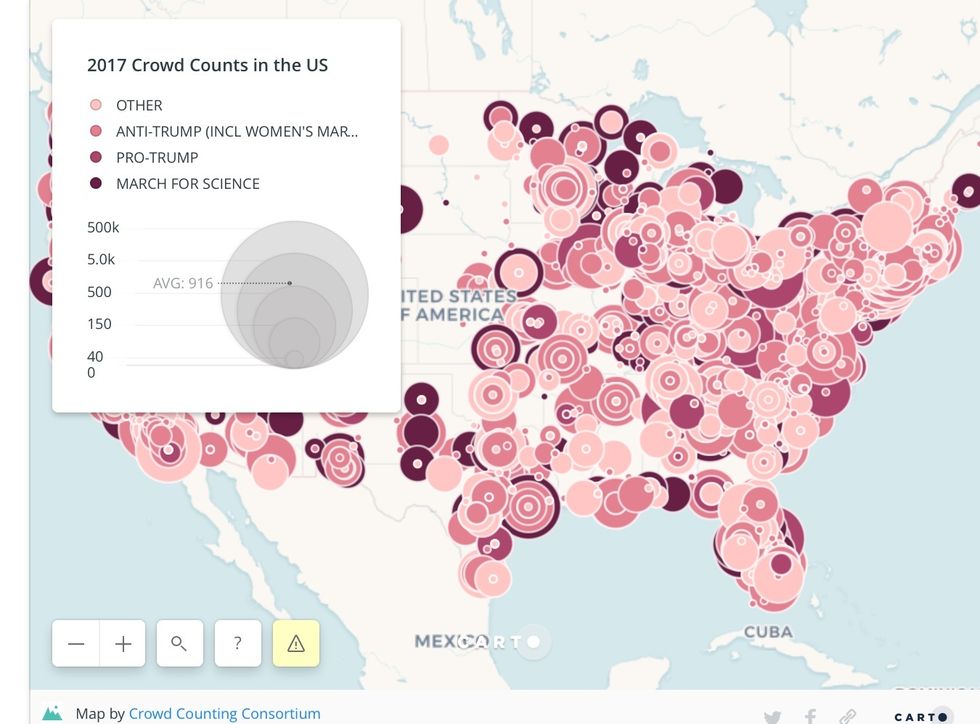One of the biggest concerns after the initial Women's March demonstrations last year was whether protesters could sustain the momentum. Would people remain interested in protesting President Donald Trump's government and the systemic sexism that led to his election?
Well, the numbers for the latest Women's March protests — held over the weekend — are in. And people are definitely still interested.
According to data from Erica Chenoweth at the University of Denver and Jeremy Pressman at the University of Connecticut, the Women's Marches over the weekend involved between 1.6 million and 2.5 million people in events across the US, with an average of 6,700 to 10,400 per march.
That's not as big as the original Women's March demonstrations — in which at least 4.2 million people participated. But the original protests were tied to a much bigger event in Trump's inauguration. The demonstrations over the weekend were tied to an anniversary and early preparation for the 2018 elections — and they still led potentially millions of people to turn out.
This is part of a broader trend. Chenoweth and Pressman have been tracking the size of protest movements since January 21, 2017, the day of the inaugural Women's March on Washington. Through December 31, 2017, they counted more than 8,700 protests in the US. About 74 percent were against Trump and his policies or views. They estimate that 5.9 million to 9 million people attended those events — the equivalent to 1.8 to 2.8 percent of the US population.
Beyond the Women's March, Chenoweth and Pressman wrote in the Washington Post, there have been many more demonstrations speaking out against Trump and his views: the airport protests against the travel ban, the Day Without an Immigrant, the Day Without Women, the March for Science, the March for Truth, LGBTQ Pride marches, rallies to save Obamacare, protests against white supremacy (particularly against the white supremacist gathering in Charlottesville, Virginia), and demonstrations against the Republican tax plan.
Chenoweth and Pressman compiled the data from all those protests, from January 21, 2017, through December 31, 2017, in a handy map (which, Chenoweth told me, will be updated with new data from the latest Women's March events soon):

These protests were overwhelmingly nonviolent, Chenoweth and Pressman found: "We find only 294 injuries and one death (of Heather Heyer in the Charlottesville car attack) during protests the entire year, fewer than 0.000005 percent of those who protested. Only 39 incidents involved reports of property damage — less than 0.5 percent of protests in 2017."
More than a coincidence, this is likely key to the protests' success, Chenoweth and Pressman wrote:
One of us, Erica Chenoweth, has done research with Maria J. Stephan that suggests people are more likely to participate in movements with public protests when the methods are visible and easy for people to participate in regardless of their levels of experience and their tolerance for risk. This is why nonviolent methods tend to be more gender-, age-, and ability-inclusive. And the more people who participate, the less risky it is for each individual to participate — which tends to bring out still more people in a self-reinforcing cycle. That's why the average nonviolent resistance campaign has so many more active participants than the average armed rebel movement, for instance.
The result is a sustained protest movement against the Trump administration — one that has held up in the year after his inauguration, and that attracted millions againover the weekend.
Vox, January 23, 2018
###
January 25, 2018

